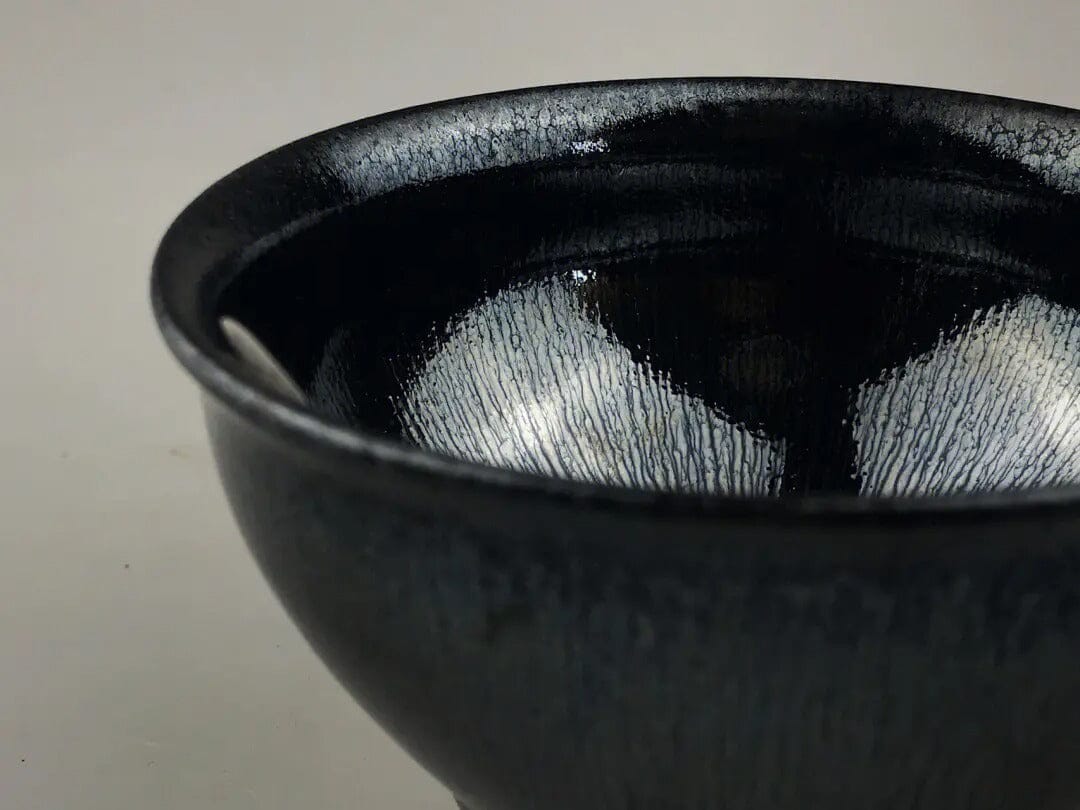Glaze color is the first criterion for judging "Tenmoku" and is also the most crucial aesthetic factor. As personal aesthetics vary, there are no fixed standards. The traditional glaze colors of "Tenmoku" commonly include "tumao" glaze, "youdi" glaze, "zhegu" glaze, "wu jin" glaze, and "yao bian" glaze. The greatest charm of "Tenmoku" from the Jian kiln lies in the infinite changes in glaze color, with a single color going into the kiln and a multitude of colors coming out. In the following passage, I will introduce in detail the 5 most distinctive glaze colors of "Tenmoku" to see which one will attract you the most.
- "Tumao" Zhan: the most representative and produced in the largest quantity.
"Tumao" Zhan is the most representative product of "Tenmoku" and is also produced in the largest quantity. The mechanism for the formation of "tumao" silk is highly related to the high iron content in the body and glaze of "Tenmoku". During the high-temperature firing process, bubbles generated by the heat in the glaze carry iron particles from the glaze to its surface. When the temperature reaches above 1300℃, the glaze flows, and the iron-rich part overflows the surface and drips downwards. After a period of cooling, the metal medium crystallizes and forms slender stripes that resemble "tumao".
- "Youdi" Zhan: the formation process is more accidental.
Most "youdi" zhan form in the same way as "tumao" zhan, but they cool down before the iron-rich portion overflows the surface and drips downwards. In ancient times, it was difficult to judge precisely when the metal medium had just overflowed and needed to be cooled immediately, relying solely on experience. Therefore, the formation of "youdi" zhan is more accidental than "tumao" zhan.
- "Zhegu" Ban: artificially decorated.
The glaze surface pattern has white spots resembling the feathers on the chest of a "zhegu" bird. The porcelain pieces of "tumao" zhan from the ancient kiln site in Yongji town, Jianyang are covered with this pattern, but the porcelain pieces of "zhegu" ban zhan are almost never seen. Why is it that "zhegu" ban zhan from the Jian kiln that have been passed down to this day are so rare, like finding a needle in a haystack?
This is because the processing technology of "zhegu" ban zhan from the Jian kiln is relatively complex. First, a glaze is applied to a black-glazed zhan, and then lead white is dripped onto it in a spotted pattern before firing in the kiln. The result is that the efficiency of this method is very low. Either the lead white melts and falls off at high temperatures, or it fails to adhere due to under-firing. As a result, there are very few intact "zhegu" ban zhan that have been passed down through the ages.
- "Wu Jin" Zhan: It was extremely difficult to produce pure black glaze a thousand years ago.
The single-colored "Tenmoku" from the Jian kiln range from light to dark, culminating in pure black. They have a very rich range of intermediate shades, and the most precious of them all is the pure black "Tenmoku". Firing pure black glaze requires a high temperature and a completely oxygen-free atmosphere inside the kiln.

During the Northern Song Dynasty over a thousand years ago, it was very difficult to produce pure black glaze because the kilns used in the southern region for firing porcelain were "dragon kilns" with poor airtightness, making it easy for air to flow in.
The majority of the ancient black glazed ceramics we see today are of a dark brown or soy sauce color, and some have a yellowish color resembling the color of a rotten persimmon. This is because it is difficult to achieve a completely oxygen-free atmosphere inside the kiln.
- Yao Bian: A unique kiln transformation with special characteristics.
"Yao Bian" is the name given by the Japanese to a special kiln transformation of Jian ware. Three "Yao Bian" Jian wares are housed in the Ryukoin of the Daikakuji Temple in Kyoto, the Shokado Bunko in Kyoto, and the Fujita Museum in Osaka. These Jian wares have irregular circular spots on them and reflect different colors of light under different lighting conditions. The Japanese have designated these three Jian wares as "National Treasures." This type of Jian ware belongs to the category of "transformation."
Until now, its craftsmanship has been very difficult to replicate completely.









Share:
3 Things to Avoid to Cultivate Tenmoku's Seven-Color Light
Imperial Seal of Approval: Decoding the Tea Ware Craftsmanship Reserved for Emperors